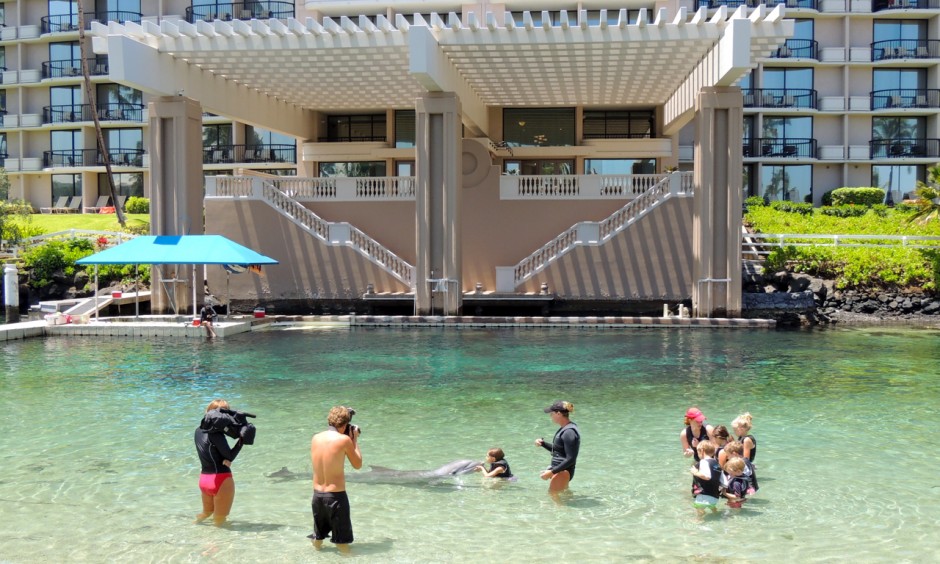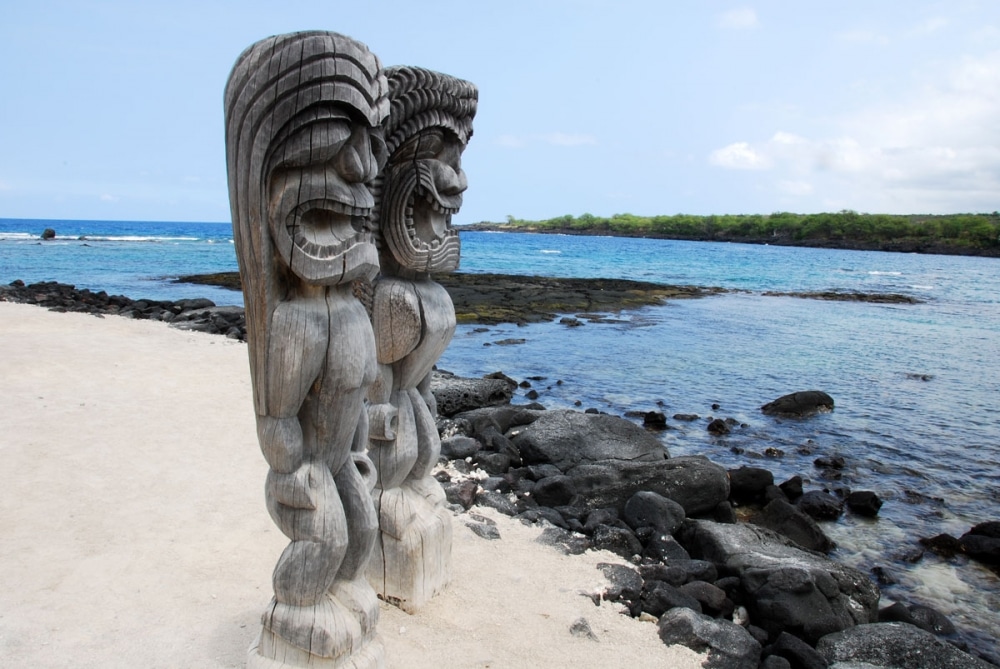The Kohala Coast on the Big Island of Hawai’i is spectacular. For miles north and south, the lava-rock shoreline is broken by tree- and palm-lined beaches. Thirty miles across the sea, the islands of Maui and Lanai are often visible. To the north the Kohala Mountains rise gently inland, and to the west, the immense volcanoes, Mauna Kea and Mauna Loa, show their peaks on clear days. There are many ancient Hawai’ian sites here, including temples, burial mounds, petroglyphs, and beautiful large mixed salt and fresh water pools in which the ancient people ingeniously trapped fish.
Because of the area’s beauty and abundant sunshine, it has attracted leisure industry developers, who have built several mega-resorts, which now clutter what should be a pristine pubic preserve. These resorts are not unattractive, and we have walked through most of them, taking advantage of the fact that they cannot deny public access to the ocean.
The largest vacation retreat is the The Hilton Waikaloa Village, which stands on sixty-two acres facing the Pacific Ocean and employs more than 1,000 people, making it the largest private-sector employer on the island. These workers are needed to service two professional-level golf courses, a four-acre ocean-fed lagoon large enough for paddleboards and canoes, three other pools, complete with waterfalls and slides, a lavish spa, fourteen restaurants and bars, mahogany canal boats and air-conditioned trams to transport guests around the resort. And a dolphinarium called “Dolphin Quest.”
The dolphins are a major attraction. Their pool is in the open along a sidewalk, next to the lagoon and about thirty yards from the ocean. Anyone can stop and watch them perform in response to their trainer’s commands, and guests can pay for a variety of special arrangements in which they can feed the animals, pet and swim with them, even train them for a day or week. The prices for these range from $110 for your 2-4 year-old toddler to spend ten minutes with a dolphin to $3,250 for you to be “trainer for a week,” which includes 5 ½ hours over five consecutive days “getting to know your best friend.”
We have twice stopped for brief periods to watch the dolphins, each time with growing dismay. We were upset to see what some scientists believe to be second only to humans in intelligence—even able to think about the future—swim endlessly in circles around a shallow pool, and then be petted by tourists for jumping, demonstrating their swimming prowess, and “laughing” while someone films the affair for the edification of the paying customers. We were struck by the irony of entrapped animals in close proximity to sea turtles and fish that can move freely from the lagoon to the sea.
We knew from seeing films like The Cove that dolphins in captivity suffer severe stress. We have since learned that confined dolphins have shorter life expectancies that those in their natural habitat—despite ample food and an absence of predators—and are more prone to diseases. A report from People for the Ethical Treatment of Animals (PETA) informs us that
Trainers force marine mammals to learn tricks, often by withholding food and isolating animals who refuse to perform. One trainer at Hersheypark quit because she saw “a lot of frustrated animals that would die from ulcers.” A marine-mammal behavioral biologist in Seattle says that captive dolphins demonstrate a variety of stress-related behavior such as self-inflicted wounds, induced vomiting, and aggressiveness. Some captive dolphins have reportedly taken their own lives by hitting their heads against the sides of pools or by refusing to come up for air.
We wondered where the Hilton obtained its dolphins. The Cove shows some horrific scenes from the annual dolphin slaughter at Taiji, Japan. The mammals are driven into a cove, then some are selected to sell to aquariums and theme parks while the rest are killed and sold as meat. We found out that the United States now prohibits the importation of dolphins from such sources. So I called Dolphin Quest and asked how they got their animals. I was told that the original five dolphins were secured off the Florida coast (no Bottlenose dolphins have been captured in U.S. waters since 1989), but from that point on the Hilton enterprises (there are others besides the one on the Big Island) have bred their performers. The woman with whom I spoke thought this was great. No longer would these modern-day Flippers be ripped from their extended families and traumatically transported to a pool or tank somewhere far away. However, we don’t see much improvement here, given that captivity itself inflicts great damage. She also cheerily told me that Dolphin Quest thought of their charges as “ambassadors,” presumably to those who watched the shows and then devoted some of their time to making sure that the dolphins who lived in the ocean are as protected as possible. This seems a dubious hypothesis.
Dolphin Quest does contribute some of its revenues to research. I couldn’t find out how much money, but there is a list of completed studies on the web site. No doubt, much of this work is useful, but why couldn’t this be done even if Dolphin Quest did not exist? Someone once told me that if it had not been for Andrew Carnegie, we wouldn’t have all those wonderful Carnegie libraries. Surely, this begs the most important question. Why didn’t we have publicly funded libraries? And why don’t we have publicly-funded animal research, so that private entities, which always have their own agendas, don’t have to be relied upon at all.
Before the morning show began the day of our second visit, we walked around taking pictures. A man told Karen that there were sharks in another pool. He and she talked for a few minutes, and she remarked that he seemed knowledgeable about the Hilton. He said that this was his ninth time here. Karen asked him about the dolphins. Wasn’t it perhaps a little upsetting that they were trapped in this small pool, away from their home in the ocean? He replied, “Well, they’re fed real good.” “They don’t have to worry where their next meal is coming from.” We wondered if he was one of those “ambassadors.”
On some of the beach hikes and walks we had taken in the weeks prior to our visit to Hilton Waikaloa Village, we had seen Spinner dolphins in the open ocean jumping, twirling, and flipping. There were boats and swimmers nearby, and it appeared that the Spinners were showing off for the humans, whom they really do seem to like. They were wild and free and part of a tightly knit pod. Fortunately for them, they aren’t suited to the shallow pools of dolphinariums, which use their Bottlenose relatives. As we watched the performance at Dolphin Quest, we hoped that the dolphins in the pool could not hear the high-pitched voices and clicks of their cousins out at sea. That would be unbearable.








